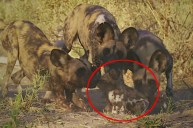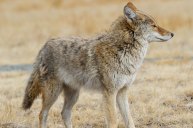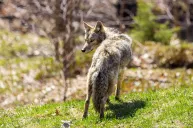Researchers say an animal like this could be as rare as one in a million.
EDITOR'S NOTE: Featured image does not reflect the subject of this article.
Coyotes aren't rare—not anymore, at least. As remarkably efficient predators, coyotes have solidified their place atop North America's ecosystem, sustaining consistent population growth year after year.
As common as America's most common wild canines have become, though, they don't often differ much in the way of looks. They're largely indistinguishable, varying little in size, coloration or overall complexion.
However, back in June 2018, National Geographic reported the sighting of a coyote with blue eyes at Point Reyes National Seashore in northern California.
About six months prior, wildlife photographer and guide Daniel Dietrich spotted the animal with his binoculars from about half a mile away, not realizing what he'd just stumbled upon.
"I didn't think anything of it until I noticed at my computer that her eye color was blue," Dietrich told Atlas Obscura. "I've taken thousands of photographs of hundreds of coyotes and have never seen that before."
Juan J. Negro, a senior researcher at the Spanish Council for Research in Spain, was at just as much of a loss as Dietrich. Negro, who's been studying animal coloration for more than 25 years, told National Geographic coyotes' eye color falls exclusively in the golden spectrum. He said puppies generally have bluish eyes that turn yellow after six weeks or so.
"I've never seen this," he said. "Deviants, or strange colors, arise from time to time as mutants."
Stan Gehrt, who researches coyotes at Ohio State University, also stressed the rarity of such a coyote.
"We have marked and handled over a thousand (adult) coyotes in the Chicago area," he said. "And we've never seen any deviation from the eye color."
According to a more recent report from National Geographic, five blue-eyed coyotes have turned up since Dietrich's first photo—two in Point Reyes, and the rest in Santa Cruz and Sacramento.
The consensus among biologists is that the blue-eyed predators are the product of a rare, genetic mutation. There appears to be no evidence supporting the notion that the unique trait came from the interbreeding of coyotes and domestic dogs.
NEXT: VIDEO: ICE FISHERMAN SLIDES ACROSS ICE TRYING TO SAVE ROD
WATCH




